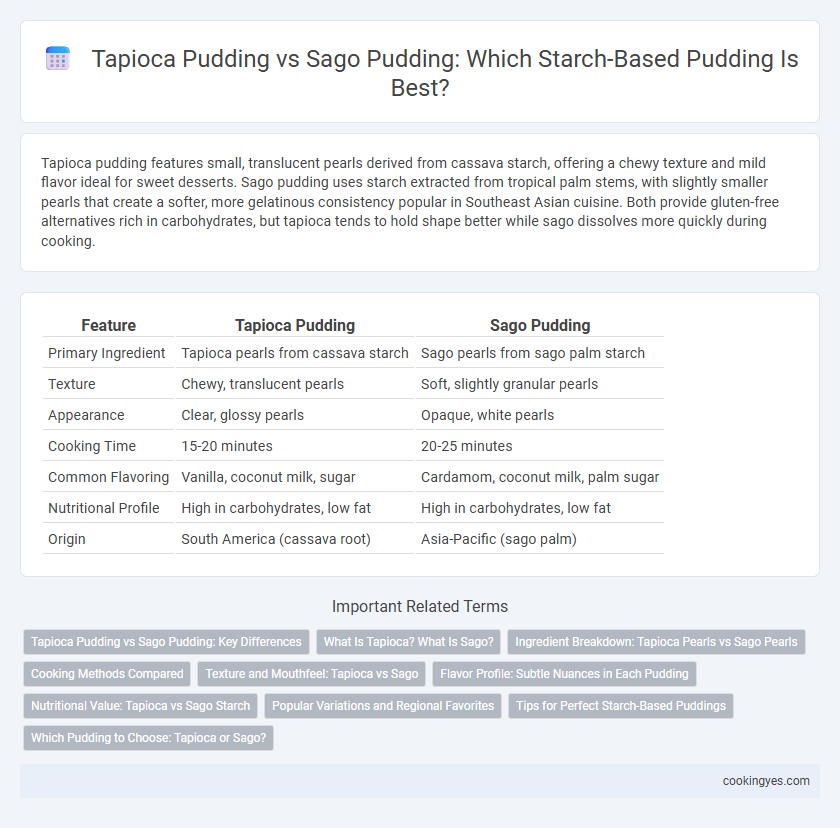Tapioca pudding features small, translucent pearls derived from cassava starch, offering a chewy texture and mild flavor ideal for sweet desserts. Sago pudding uses starch extracted from tropical palm stems, with slightly smaller pearls that create a softer, more gelatinous consistency popular in Southeast Asian cuisine. Both provide gluten-free alternatives rich in carbohydrates, but tapioca tends to hold shape better while sago dissolves more quickly during cooking.
Table of Comparison
| Feature | Tapioca Pudding | Sago Pudding |
|---|---|---|
| Primary Ingredient | Tapioca pearls from cassava starch | Sago pearls from sago palm starch |
| Texture | Chewy, translucent pearls | Soft, slightly granular pearls |
| Appearance | Clear, glossy pearls | Opaque, white pearls |
| Cooking Time | 15-20 minutes | 20-25 minutes |
| Common Flavoring | Vanilla, coconut milk, sugar | Cardamom, coconut milk, palm sugar |
| Nutritional Profile | High in carbohydrates, low fat | High in carbohydrates, low fat |
| Origin | South America (cassava root) | Asia-Pacific (sago palm) |
Tapioca Pudding vs Sago Pudding: Key Differences
Tapioca pudding is made from tapioca pearls derived from cassava root, offering a chewy texture with a slightly translucent appearance, while sago pudding uses pearls extracted from the sago palm, resulting in a softer, more gelatinous consistency. Nutritionally, tapioca contains more carbohydrates and calories compared to sago, which is lower in fat and easier to digest. Taste-wise, tapioca pudding has a neutral flavor ideal for sweetening, whereas sago pudding often has a subtle nutty note, influencing its use in regional desserts across Southeast Asia and India.
What Is Tapioca? What Is Sago?
Tapioca is a starch extracted from the cassava root, commonly used in puddings for its chewy texture and ability to thicken liquids. Sago is a starch derived from the pith of tropical palm stems, favored in desserts for its translucent pearls that add a gelatinous consistency. Both tapioca and sago are gluten-free starches, but tapioca's origin in cassava root differentiates it from palm-derived sago, influencing their cooking properties and texture in starch-based puddings.
Ingredient Breakdown: Tapioca Pearls vs Sago Pearls
Tapioca pudding is made from tapioca pearls derived from cassava root starch, characterized by their smooth, slightly translucent texture and neutral flavor that readily absorbs sweeteners. In contrast, sago pudding uses sago pearls extracted from the pith of tropical palm stems, which tend to be smaller, more opaque, and produce a chewier consistency. Both pearls function as starch-based thickeners, but tapioca pearls offer a more consistent gelatinous texture, while sago pearls provide a rustic mouthfeel and distinct bite.
Cooking Methods Compared
Tapioca pudding requires soaking tapioca pearls before simmering them in milk or coconut milk until translucent and thickened, creating a creamy texture. Sago pudding involves boiling sago pearls directly until they become soft and gelatinous, often stirring continuously to avoid clumping. The cooking method for tapioca emphasizes gradual heat and soaking, while sago demands vigorous boiling and constant stirring for optimal consistency.
Texture and Mouthfeel: Tapioca vs Sago
Tapioca pudding features a chewy, slightly translucent texture, providing a pleasantly resilient bite that enhances mouthfeel with its small, uniform pearls. Sago pudding offers a softer, more gelatinous consistency with slightly larger granules that create a smoother, creamier sensation on the palate. The distinction in starch granule size and gelatinization properties between tapioca and sago directly influences the overall tactile experience in starch-based puddings.
Flavor Profile: Subtle Nuances in Each Pudding
Tapioca pudding features a creamy texture with a mildly sweet and slightly nutty flavor, offering a smooth palate experience. Sago pudding presents a more gelatinous consistency and a neutral taste, allowing added ingredients like coconut milk or palm sugar to shine through. Both puddings highlight subtle starch-derived nuances, with tapioca leaning towards a richer mouthfeel, while sago delivers a lighter, more delicate flavor.
Nutritional Value: Tapioca vs Sago Starch
Tapioca pudding contains tapioca starch derived from cassava root, offering a gluten-free option with moderate carbohydrates and minimal fat, making it suitable for low-fat diets. Sago pudding, made from sago palm starch, provides similar carbohydrate content but tends to have less protein and fiber compared to tapioca. Both starches supply energy primarily through carbohydrates, but tapioca starch delivers a slightly higher nutritional value in terms of digestibility and micronutrient content.
Popular Variations and Regional Favorites
Tapioca pudding, made from cassava starch pearls, is favored in North America and often enhanced with vanilla or coconut milk, while sago pudding, derived from palm starch, enjoys popularity in Southeast Asia with regional twists such as pandan flavoring or palm sugar. Both starch-based puddings share a similar gelatinous texture but differ in pearl size and cooking methods, influencing their distinct regional identities. Popular variations also include incorporation of fruits, spices, or dairy, reflecting local tastes and culinary traditions.
Tips for Perfect Starch-Based Puddings
Achieving the ideal texture in tapioca pudding requires soaking the pearls before cooking to ensure even gelatinization and prevent clumping, while sago pudding benefits from gentle simmering to avoid a gummy consistency. Use a precise starch-to-liquid ratio, typically 1:4, and constant stirring to maintain creaminess and prevent sticking. Incorporating a small amount of fat like butter or coconut milk enhances mouthfeel and flavor in both tapioca and sago puddings.
Which Pudding to Choose: Tapioca or Sago?
Tapioca pudding offers a chewy texture with small, translucent pearls derived from cassava starch, while sago pudding features larger, more opaque pearls extracted from tropical palm starch. Nutritionally, tapioca is generally low in protein and fat but provides quick energy through carbohydrates, similar to sago, though sago may have slightly higher fiber content depending on preparation. Choosing between tapioca and sago pudding depends on preferred texture and regional availability, as tapioca is more common in Western cuisines and sago is a staple in Southeast Asian desserts.
Tapioca Pudding vs Sago Pudding for Starch-Based Puddings Infographic

 cookingyes.com
cookingyes.com